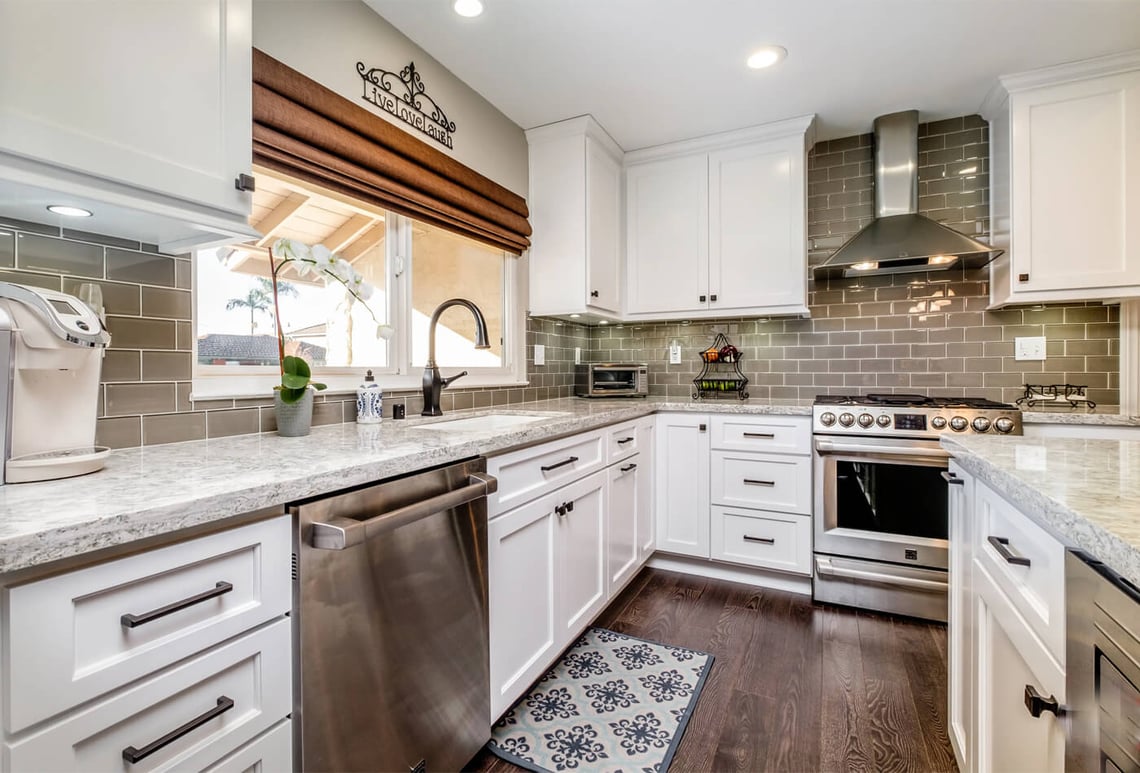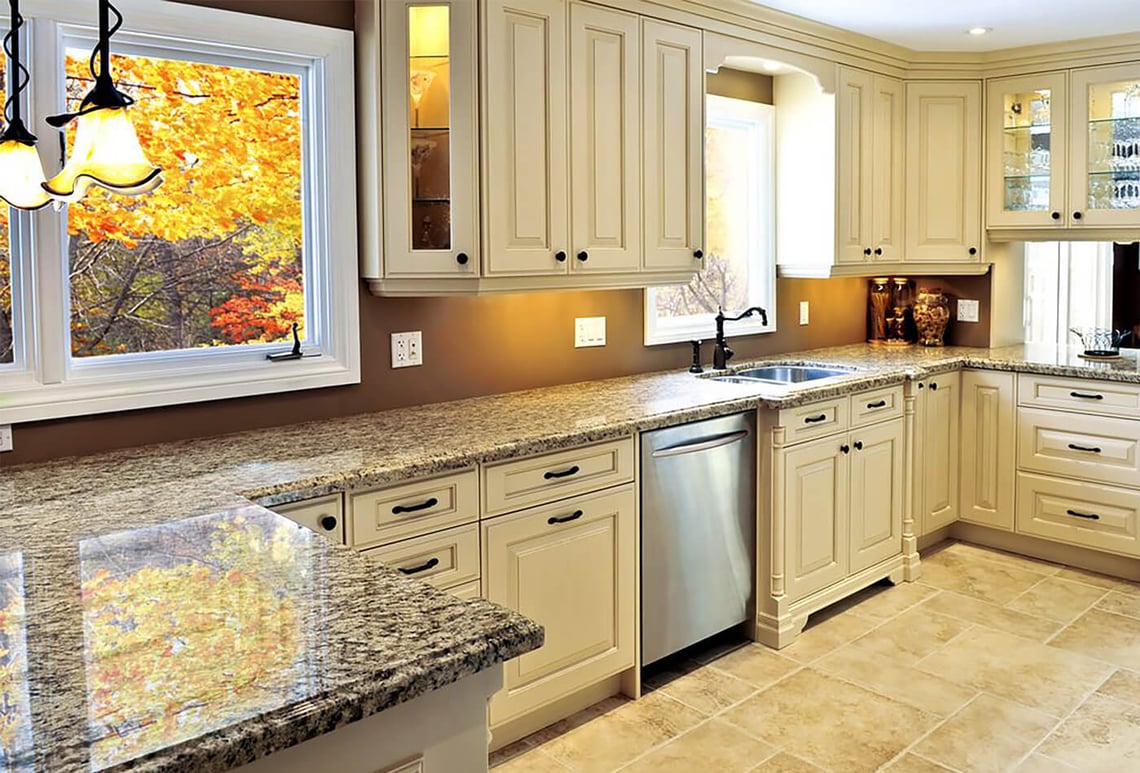Table Of Contents
In the context of interior design, a textural kitchen refers to a kitchen that places a strong emphasis on textures and materials. This involves using a variety of materials, such as wood, stone, glass, and metal, to create a visually and tactilely rich environment. The use of different textures can add depth and character to a kitchen space. Contrasting colours, spectacular furnishings, mind-blowing surfaces, and other features will all be present in a textured kitchen.
There are countless possibilities when designing a textural kitchen, which will be discussed in this blog.
Why Is Texture So Pivotal?
Texture will give you a wide variety of choices, space to apply your own ideas, and also give your kitchen a mortal touch, which will personalise the space for you. Your kitchen's background and colour scheme should fluently go with the texture you choose to employ there.
What Qualities Define A Textural Kitchen?

The first and foremost thing we need to keep in mind while selecting a textural pattern for your kitchen is that it must blend in with the background colour, theme, and artwork. The furniture and kitchenware you are choosing should also blend with the entire design scheme.
COLONIAL WHITE SENSA
£455.00 Colonial White Sensa is a granite slab that features a combination of cottony-pale grey, hazy silver, and reddish speckles. The sensa surface will undoubtedly lend a characteristic modern touch to almost any kitchen or bathroom area. This excellent granite has… read more |
SNOWY IBIZA SILESTONE
£470.49 Snowy Ibiza Silestone is composed of 94% natural Quartz, making it an extremely durable and resilient stone. This is the only Quartz worktop with anti-bacterial protection, offering sanitary features not found elsewhere on the market. It's a good surface for… read more |
How To Add Texture To Your Kitchen
-
Choose Natural Materials

Use natural materials like stone, Cobbles or wood for various elements in your kitchen. Wooden beams, stone countertops, or cobble accent walls can introduce texture and a rustic feel.
-
Textured Countertop Finishes
Opt for textured countertop materials like honed granite, leathered quartz, or marble. These surfaces have a tactile quality that adds interest to the kitchen. Countertops, the most important aspect of creating a kitchen’s look and feel, can be textured. Choosing vintage finishes for your countertops will add warmth and a tactile texture. Because of the large surface area they cover and their increased visibility, countertops will serve as a major focal point. Granite is the most popular material used in countertops because it is more hygienic, highly durable, and requires very less maintenance if sealed. But other stones, like marble, can also be used to create a textural kitchen countertop, as they have natural veining textures.
-
Backsplash

The choice of backsplash/splashback can complement the cabinet texture. Textured backsplash tiles or a textured stone countertop can enhance the overall texture of the kitchen. You can choose the colour of your backsplash depending on the theme of your kitchen. We have both natural and engineered stones such as marble, granite, and quartz in a variety of colour options - beige, black, grey, and a lot more.
-
Cabinets
Combining different materials for your cabinets, such as a mix of wood and glass or metal accents, can introduce various textures within the kitchen design. The style of cabinet doors can contribute to the overall texture. Raised panel doors, for instance, have a three-dimensional texture due to their raised centre panels, while flat-panel doors offer a clean and minimalist look.
VANCOUVER SENSA
£586.62 The Brazilian quartzite, Vancouver Sensa has a white background and a vast variety of veins that are either more sometimes less dense, tiny, wide, interwoven, or disconnected. This surface appears to be cracked but looks inviting to touch as it… read more |
PIRENEI ECRU FULLBODY3D PORCELAIN
£391.63 Pirenei Ecru Fullbody3D Porcelain is a light-grey slab that features tiny black dots which move in a linear manner if observed closely. It is sure to suit the taste of those that love rustic and country style interiors. Installing this… read more |
-
Textured Tableware
Display textured dishware and ceramics on open shelves or in glass-front cabinets. These items can double as both decor and functional elements.
-
Wall Artwork And Decor:

It is significantly easier to create a textural kitchen by pouring your creativity into the walls. There are several options to add texture to your wall. But setting the tone of the design is basically influenced by the colour of the wall, background, and hangings. Hang textured artwork, tapestries, or decorative wall panels to adorn your kitchen walls. These pieces can introduce texture while showcasing your personal style.
-
Open Shelving

Incorporate open shelving with textured brackets or supports. This not only adds texture but also allows you to display decorative items and textured dishware.
-
Plants And greenery
Bring in potted plants and herbs. The natural textures of foliage can soften the kitchen and make it feel more inviting, thus keeping your textural kitchen closer to nature.
-
Textured Lighting
Choose pendant lights or fixtures with textured shades or intricate patterns. The play of light and shadow can create a textured effect
What Colours To Use In A Textural Kitchen

-
Cream
Cream is one of the best options when it comes to elegance and coherence. It shows off steadiness and homeliness. It also goes well with wooden furniture and artwork.
Fan of light tones? To declare your love for them, click here for more breathtaking, lighter tones.
-
Copper
Copper will steal the show when it is incorporated into your kitchen interior. This eye-catching colour can also be used on walls or backsplashes. Copper will reflect the lights and stage a kaleidoscopic show in your kitchen. Also, it is very easy to maintain and clean copper stone works. Need more darker shades, like copper? Visit here.
FANTASY BROWN GRANITE
£321.10
Fantasy Brown Granite is really distinctive natural stone . Numerous names for this stunning stone include Canyon Dawn, Brown Fantasy Granite, Fantasy Brown Marble, Fantasy Brown Dolomite, and Fantasy Brown Quartzite. This igneous stone has a long, distinguished history. Fantasy… read more |
BIANCO CRISTAL COMPOSITE QUARTZ
£311.31 Bianco Cristal Composite Quartz is a white stone manufactured by the Brenton Technology. It is made of quartz and silica with polyester resin acting as a binder. They are bounded with astounding mirrors and chips giving individuality and personality to… read more |
-
Grey
The biggest benefit of going with grey is that there are a tonne of different shades of it, so you can pick the one that best represents you. Grey usually hides stains, so frequent cleaning is not needed. Grey can complement almost all background themes, furnishings, and decorations. Check out our mirror shades if you want a unique looking kitchen.
Important Tip To Balance Kitchen Texture

Remember that balance is key when adding texture to your kitchen. Avoid overwhelming the space with too many textures. Instead, mix and match textures strategically to create a cohesive and harmonious look that suits your personal style and the overall design of your kitchen.
For more tips on kitchen renovation and for inquiries about exciting stone collections, contact us at +44 0330 113 5868 or email info@work-tops.com, and one of our experts will get in touch with you shortly.
Frequently Asked Questions:
-
How Could Kitchen Walls Be Given A Texture?
To add texture to kitchen walls, the vast majority of homeowners elect for wood panelling or imitation masonry. Employing diverse painting techniques and textured wallpaper are two additional options for bringing texture to kitchen walls. However, be conscious not to use too much. As an accent wall, one wall should be sufficient.
-
How Are Kitchen Cabinets Textured?
Enhance your kitchen cabinets by incorporating fabric. To construct an edge or shelf on the rear of the door for supporting the fabric, start by cutting out the middle of the door using a jigsaw. Sand the door lightly and paint it.
-
Two Main Methods Of Texture
Visual texture involves the ability to see the shape or content of the surface, and tactile texture describes the actual physical sensation of a surface.
P.S. The readers are informed that none of the content available on any of the pages of Work-tops.com should be taken as legal advice and that Work-Tops will not be held accountable for your use of the information contained in or linked from these web pages.




